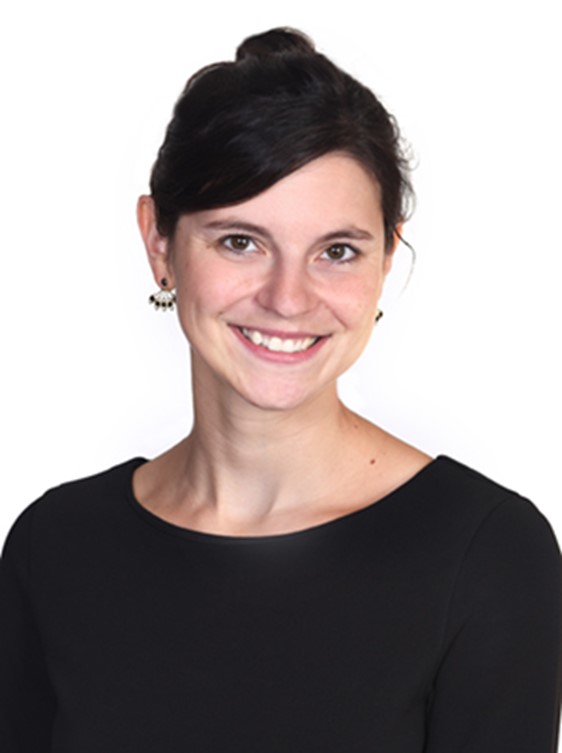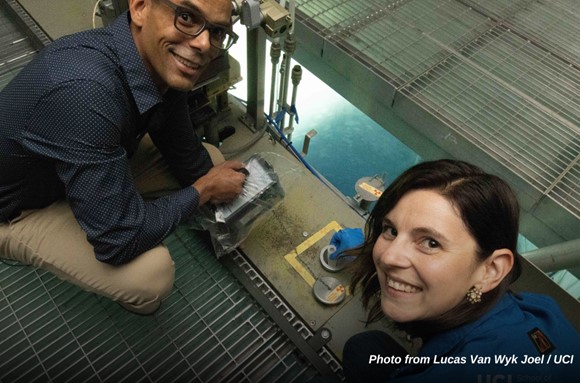Spotlight on Faculty — Sarah Finkeldei
A new age has dawned for UCI's nuclear reactor facility. AirUCI faculty Sarah Finkeldei came to UCI in 2019 and promptly began to work in the reactor facility, which was built 1968 and first brought to power in 1969 by the late Sherry Rowland, honorary AirUCI faculty. Our nuclear facility has a storied history and Sarah's work is giving it new life, opening new possibilities and new collaborations. She joined our AirUCI faculty in 2022.
The research conducted by Sarah and her team focuses on transport phenomena in advanced nuclear fuel candidates as well as closing knowledge gaps regarding the behavior of spent nuclear fuel in a deep geological repository. They are developing tailored fabrication methods for advanced nuclear fuel candidates, and subsequently study their behavior under extreme conditions to derive a fundamental understanding of the structure property relationships under in-reactor conditions.
The studies of Sarah and her team at the back end of the nuclear fuel cycle are aimed toward unraveling redox chemistry of spent nuclear fuel embedded in its cladding material and a waste canister in the case of technical barrier failure in a deep geological repository.
In 2021 Sarah was awarded a $75,000 grant from the U.S. Department of Energy, Office of Nuclear Energy that has gone into upgrading our 50-year-old nuclear reactor operated by UCI’s Chemistry Department. The grant enabled Sarah and her co-PI John Keffer — the facility manager and senior reactor operator of UCI’s TRIGA reactor facility — to modernize the reactor control via a digital log recorder and an auxiliary support system to enhance the training experience of the next generation of UCI’s nuclear scientists. These upgrades will increase reliability of the reactor’s instrumentation and control systems and will improve radiation safety.
“The modernization of our reactor will enable us to simultaneously log data with much higher accuracy, opening up new research opportunities for our students and external users,” said Sarah. “Being the only educational institution in Southern California with such a facility, we are committed to providing the best environment to students who are interested in nuclear technology.” Beyond advanced fuel types for the current reactor fleet, next generation reactors  including small and micro modular reactor designs are rapidly becoming a viable option for transitioning the planet away from carbon-based energy sources. Sarah, in collaboration with other scientists at UCI and at Los Alamos National Laboratory, was awarded a $4.3 million grant in 2022 from DOE to advance fundamental research on the properties of advanced nuclear energy materials to further our understanding of their behavior in current and advanced nuclear reactors.
including small and micro modular reactor designs are rapidly becoming a viable option for transitioning the planet away from carbon-based energy sources. Sarah, in collaboration with other scientists at UCI and at Los Alamos National Laboratory, was awarded a $4.3 million grant in 2022 from DOE to advance fundamental research on the properties of advanced nuclear energy materials to further our understanding of their behavior in current and advanced nuclear reactors.
Under this grant, Sarah and Professor Shen Dillon of UCI’s Department of Materials Science and Engineering (shown here) are studying how radiation, extreme temperatures, and stress impact the behavior of advanced nuclear fuels during in-reactor operation. Applying data collected from irradiation experiments at our own TRIGA reactor at UCI, at the Ion Beam Materials’ Laboratory at LANL, as well as modeling techniques, they will work with their collaborators to increase our understanding of how extreme conditions impact the transport properties along grain boundaries of these materials over time. “We are gaining momentum that will position UCI among key players in nuclear materials research,” said Sarah. “These are extremely exciting times.”
Making use of our reactor in an entirely different direction, Sarah and John Keffer, our nuclear facility manager, have recently been collaborating with nuclear technology company Serva Energy. Working in our reactor facility, in 2023 the team developed a reactor–based method of production and succeeded in creating an isotope called Actinium-225 which shows great promise for treatment of certain types of cancer, including late-stage cancers. Serva Energy announced that this “marks the first time a commercial entity has employed a conventional nuclear reactor to produce the lifesaving isotope—allowing for dozens of existing research reactors around the world to collaborate with Serva on increasing production of Actinium-225 without huge capital investments or delays for construction.” Sarah expects this collaboration with Serva Energy will lead to similar projects in the future.
UCI's nuclear reactor facility is also working to support the training of the next generation of nuclear scientists through DOE funding for undergraduate involvement in facility activities. Just in the last year the U.S. Nuclear Regulatory Commission also licensed four undergrad and grad students as nuclear reactor operators upon their completion of a year of training with Chemistry Professor A.J. Shaka (facility director of the TRIGA reactor at UCI), John Keffer, and Sarah at UCI's nuclear reactor facility.
“Having undergraduate students there to help with the project allows for the training of the next generation of nuclear scientists right here at UCI,” said Sarah. Undergrads “get industry contacts, and they work hands-on at the reactor. There aren’t many places in the U.S. or the world, where you can do that.” Her program at UCI is one of the few places in the world that offers such an opportunity, and Sarah sees this student involvement as key to the future of UCI's nuclear facility. Continued expansion of UCI’s nuclear capabilities will allow establishment of new directions in nuclear research, such as the recent medical isotope developments, she said.
For their work at UCI's nuclear reactor facility, AirUCI undergrad Jack Shire received a $10,000 scholarship from the DOE’s Office of Nuclear Energy under their University Nuclear Leadership Program, thanks to a DOE grant awarded to Sarah that lets UCI students apply for scholarships and fellowships over the next 10 years.
On top of all the reactor modernization, training, and research on campus, in 2023 Sarah created and organized a Nuclear Science Workshop alongside Director Dr. Mavrik Zavarin of the Seaborg Institute at Lawrence Livermore National Laboratory (LLNL) funded by UC Office of the President. The one-week workshop was held at LLNL and the University of California Livermore Collaboration Center (UCLCC), and it provided 20 undergrads from several UCI departments with a hands-on opportunity to learn about nuclear science, tour laboratories at LLNL, and network with members from several other national labs, including LLNL, LANL, INL, ORNL and LBNL. The workshop was held exclusively for UCI undergrads, two-thirds of whom came from underrepresented groups or were first-generation college students.
The Nicholas Endowment, a philanthropic organization located in Irvine, provided funding for the workshop this summer, which again took place at LLNL and UCLCC and hosted over 30 UCI undergraduates. Just last month Sarah received the wonderful news that her application to the Nicholas Endowment will be supported once more in 2025 to enable the summer course for the next 40 undergraduate students from UCI, thus enabling a continuation of her workforce development efforts to train the next generation of scientists in nuclear sciences
Clearly Sarah’s enthusiastic efforts are bearing new fruit and reinvigorating a historic nuclear energy tradition at UCI. We are excited to see what new directions her research takes her.
We thank Lucas Van Wyk Joel of Physical Sciences Communication office whose quotes and articles inspired much of this content.

